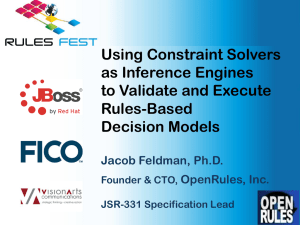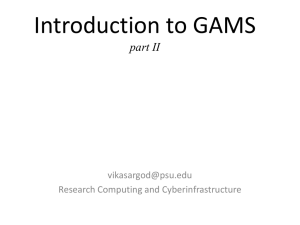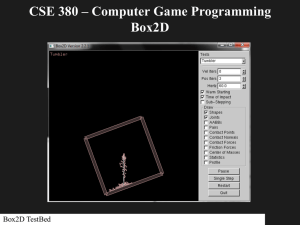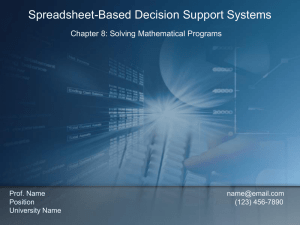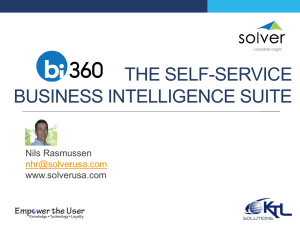Solver - DSM Forum
advertisement
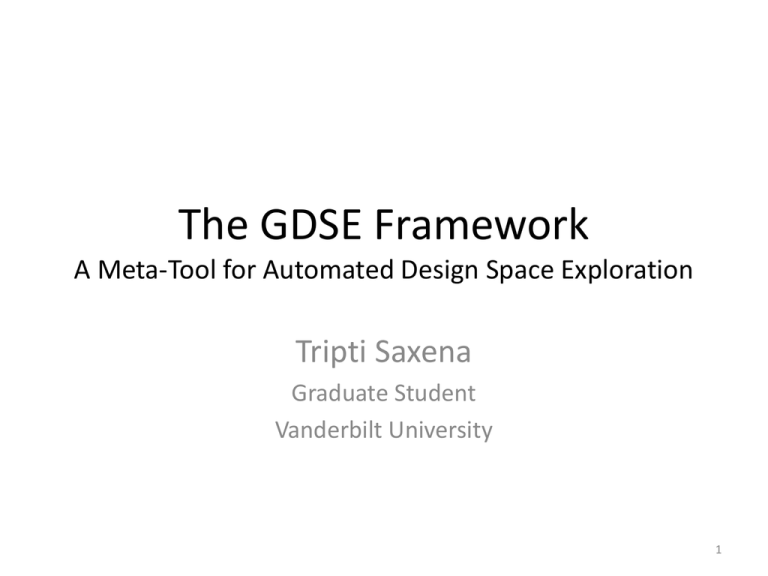
The GDSE Framework A Meta-Tool for Automated Design Space Exploration Tripti Saxena Graduate Student Vanderbilt University 1 Outline • Background • Motivation • The Generic Design Space Exploration Framework – Reconfigurable Representation – Flexible Exploration • Conclusion and Future Work 2 Background Design Space product of possible discrete design choices x2 e.g. selection of software components alternative hardware architectures selection of features design space x1 Design Space Exploration find a design point • Satisfies constraints • Is “best” w.r.t. an objective function(s) 3 Background • Software Product-line Engineering Face Recognition System [1..4] Camera Face Recognition Algorithm Image Compression PCA Euclidean LDA MahCosine Euclidean Bayesian IdaSoft MAP ML Feature Model 4 Background • Embedded Systems Hardware Application LookUp RISC EDF TDMA Priority Cipher DSP WFQ Mapping 5 Current DSE Frameworks Representation Design space Constraints Objectives Exploration Solver Exploration algorithm Examples of DSE frameworks • FAMA • Milan • SPLOT • PISA • … - Configured to solve a particular DSE problem - Supports only ONE solver/solving technique, not efficient for every problem instance. 6 Motivation A reusable and flexible framework SAT (e.g. Minisat) Hardware-Software Mapping Software Product Line configuration Mathematical Solver (e.g. LPSolve) Common core Web Server configuration Constraint Solver (e.g Gecode) Reusable Core Reconfigurable Representation Multiple Solvers 7 The Generic Design Space Exploration Framework ADSEL Template DSML GME eDSML Instance of Instance of Design Space Model Reconfigurable Representation Common Core Intermediate Language Intermediate Design Space Model t DESERT Flexible Exploration Solver Independent Constraint Problem in Minizinc Minizinc FlatZinc Solver LP Solver FD Solver Gecode Solver 8 Generic Modeling Environment MDE-based Framework Metamodeling •Meta-Programmable •Reuse of previously defined entities using libraries •Translators for synthesis Done by Domain experts Modeling Enables reconfigurable representation Done by Domainengineers 9 Minizinc Model Medium Level Solver-Independent Language Interpreter Simplified Constraints + variables Constraint Solver (Flatzinc) LP Solve •Express Combinatorial Search Problems •Predefined translators for translation to different solver specific formats Minisat Enables flexible exploration Solutions Solutions Solutions 10 Overview of the GDSE Framework DSML 1 GME ADSEL 4 Reuse existing DSML 2 Intermediate Language eDSML Instance of Instance of 3 Design Space Model Intermediate Design Space Model t DESERT Solver Independent Constraint Problem in Minizinc FlatZinc Solver LP Solver FD Solver Gecode Solver 11 Step 1: Domain Specific Modeling Language. Metamodel •Entities •Relationships •Attributes Metamodel Face Recognition Algorithm Model 12 DSE Problem: Face Recognition System 1. Construct a Face Recognition System 2. Goal: Choose a face recognition algorithm from the variants satisfying selection + resource constraints PCA DSML has to be extended to capture • Design Space of possible variants • DSE Properties •Memory •CPU •Cost • Constraints •Bound constraint : Memory <= x • Objective Algo1 Algo2 Algo3 … 13 Step 2: Metamodel Composition GME DSML 1 GME ADSEL 4 Performed by Domainexpert ONCE for a kind of DSE problem 2 Intermediate Language eDSML Instance of Instance of 3 Design Space Model Intermediate Design Space Model t DESERT Solver Independent Constraint Problem in Minizinc FlatZinc Solver LP Solver FD Solver Gecode Solver 14 The Abstract Design Space Exploration Language Template Design Space Tree COMPONENT TYPES CONSTRAINT TYPES OBJECTIVE TYPES Objective All elements are abstract ! 15 The ADSEL Component types •PropertyType •ValueType •Domain •Composition Function 16 The ADSEL Constraint and Objective types e.g. utilization e.g. A.Sel -> not B.Sel e.g. A.Memory <= 100 17 e.g.minimize (cost) Metamodel Composition: Template Instantiation 18 Metamodel Composition: Template Instantiation 19 Composition Automation: eDSML Creator • GUI • Semi-Automated Metamodel Creation based on user selection •Written in C++ 20 Step 3: Create Instance Model NA NA M 21 Step 4: Perform DSE GME DSML 1 GME ADSEL 4 2 Intermediate Language eDSML Instance of Instance of 3 Design Space Model t Intermediate Design Space Model DESERT Solver Independent Constraint Problem in Minizinc FlatZinc Solver LP Solver FD Solver Gecode Solver 22 Solutions Solver Selection Solver 23 Summary – A Generic Framework • • Reusable Flexible – Case studies from different domains • • • Software Product Line Configuration Architecture Synthesis Hardware Software Co-synthesis – Scalability: SPLE 24 Conclusion • Other use cases – Hybrid Tool: Invoke multiple solvers in series – Scalability Analysis Tool • Future Work – Wider range of case studies – Support parametric representation – Support algorithms for multi-objective optimization 25 Questions ? 26

